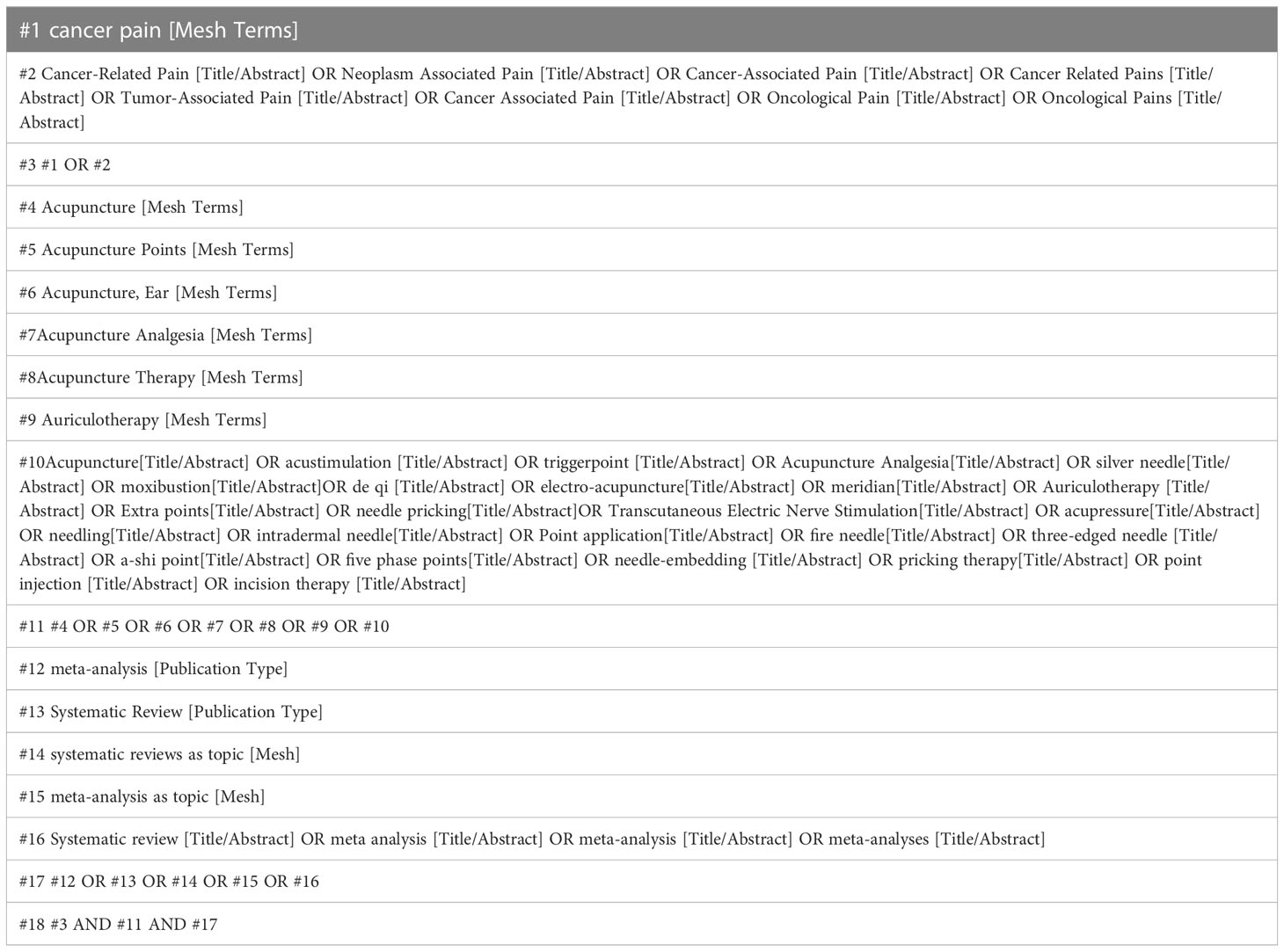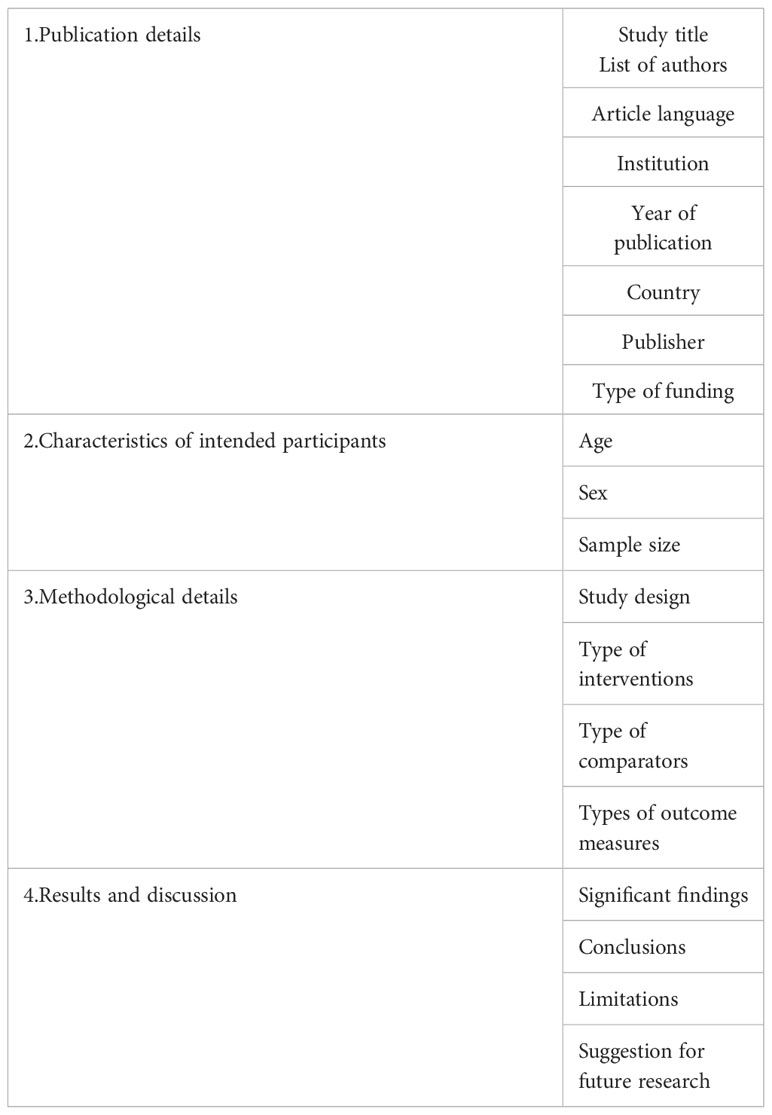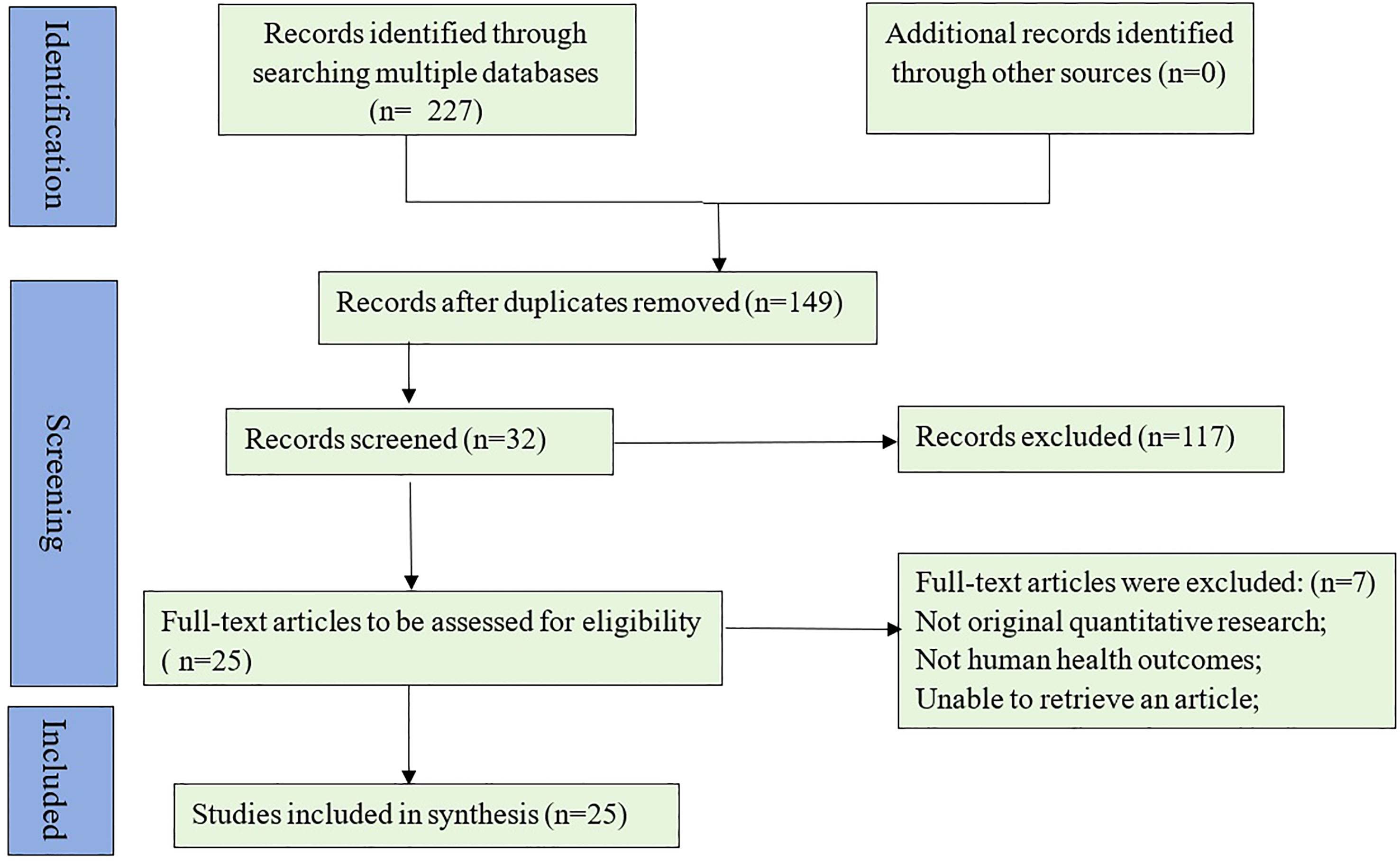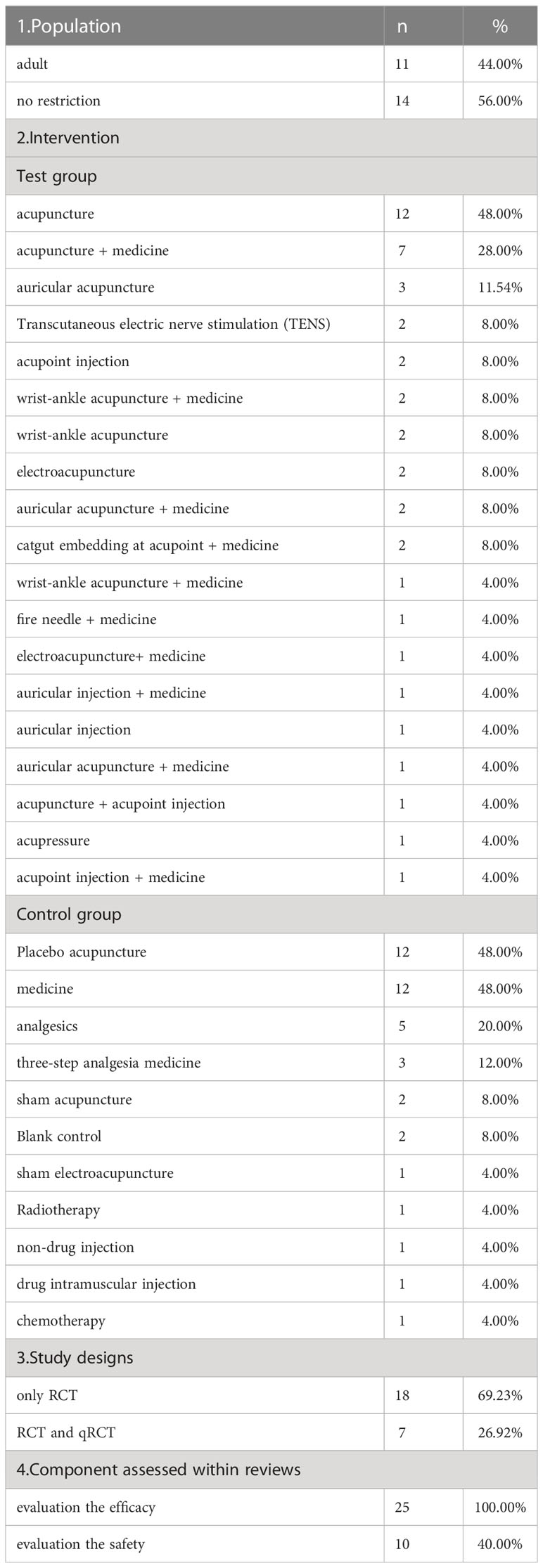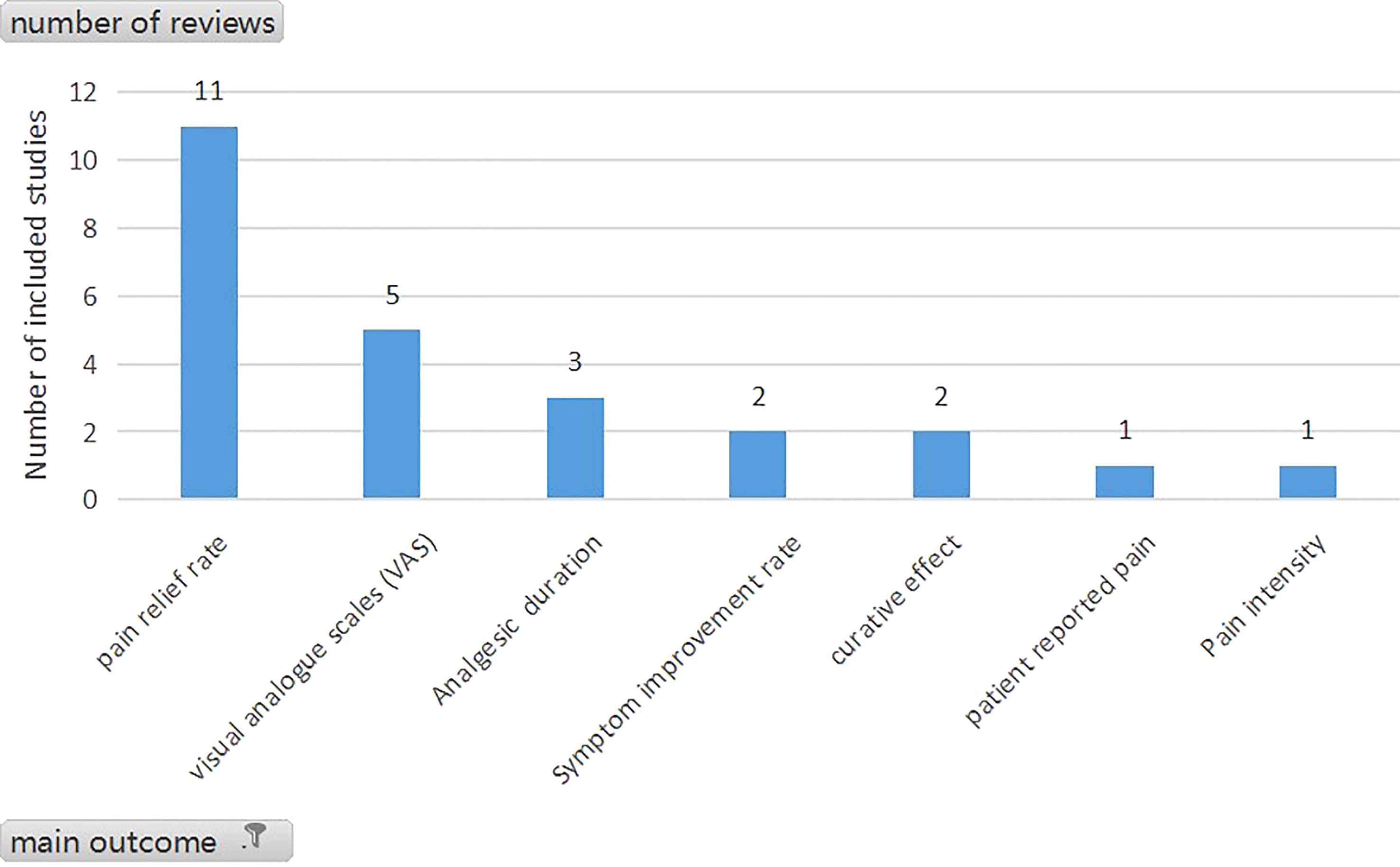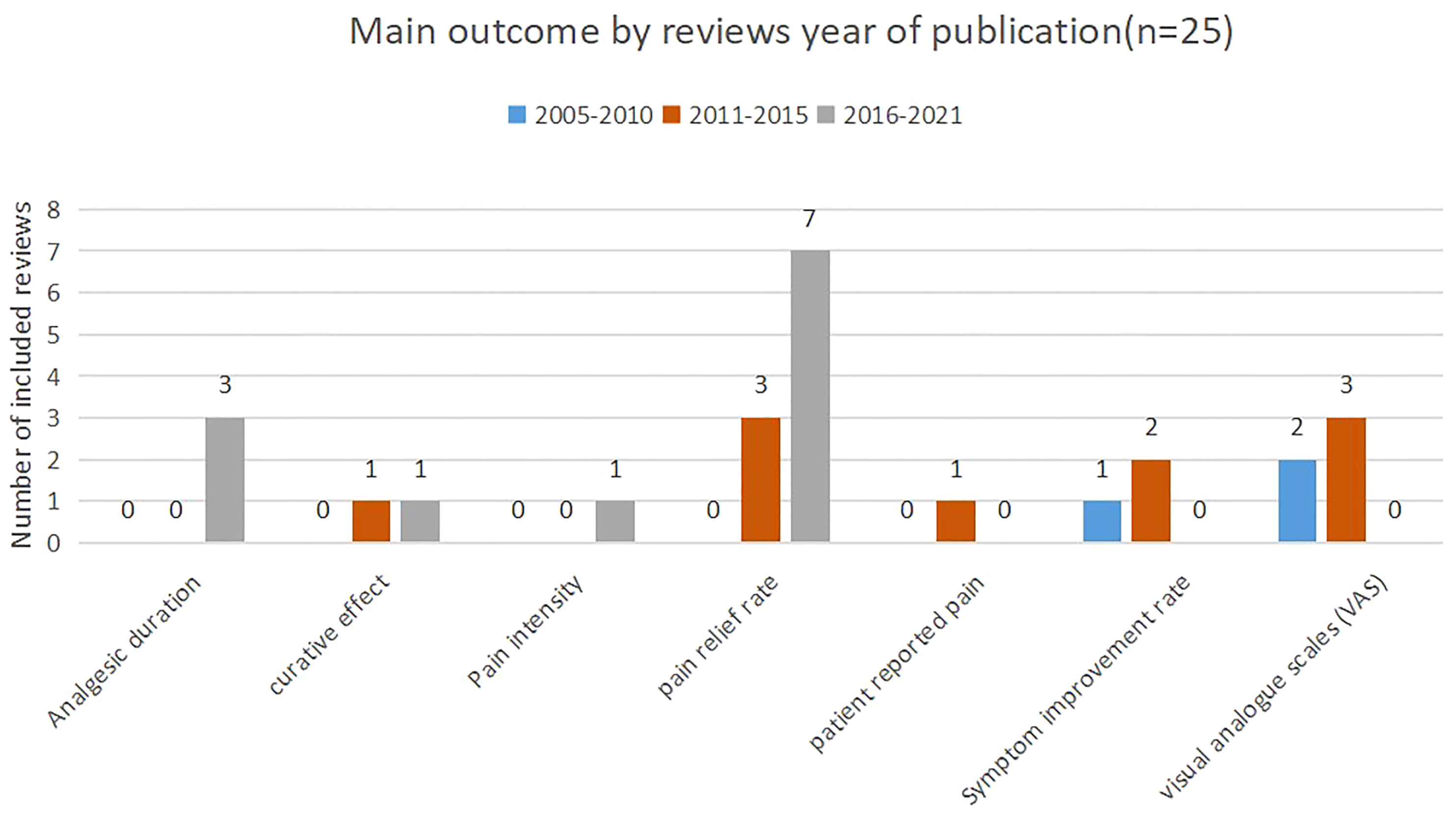- 1College of Acupuncture and Orthopedics, Hubei University of Chinese Medicine, Wuhan, Hubei, China
- 2School of Biomedical Engineering and Imaging, Hubei University of Science and Technology, Xianning, Hubei, China
- 3Xianning Central Hospital, The First Affiliated Hospital of Hubei University of Science and Technology, Xianning, Hubei, China
- 4Faculty of Medicine and Dentistry, University of Alberta, Edmonton, Alberta, AB, Canada
Background: Due to the effectiveness and safety, acupuncture, one of the traditional therapies of Chinese medicine, has been widely used in clinical practice globally. A few systematic review or meta-analyses have proved its effectiveness and safety towards patients with cancer pain, while there are no syntheses among those evidence. The aim of this scoping review is to summarize the evidence from systematic reviews of acupuncture for the treatment of cancer pain and evaluate the breadth and methodological quality of these evidence as well.
Methods: The scoping review process was guided by the methodology framework of Preferred Reporting Items for Systematic Reviews and Meta-Analyses extension for scoping reviews (PRISMA ScR) and “Arkseyand O’Malley six-stage framework”. Electronic searches were carried out in several online databases from inception to Jan 2022. Systematic reviews and meta-analyses that involve any type of acupuncture for patients with cancer pain will be included. A pair of reviewers independently screened full texts. Moreover, review characteristics were extracted, and methodological quality was assessed using the AMSTAR 2 tool.
Results: Twenty-five systematic reviews and meta-analyses were included. Manual acupuncture is the most frequently included types of test group intervention (48%), followed by acupuncture + medicine (28%), and auricular acupuncture (12%). All the reviews have declared that acupuncture is an effective method for cancer pain treatment. Eleven reviews (44%) aiming at evaluating the safety also have confirmed that acupuncture is safe for treating cancer pain. However, most included studies were conducted in China. With certain geographical limitations, the findings were not representative within the region. The results of our review may owe to the synthesis of all kinds of cancer pain, and only 2 reviews described the type of cancer pain in detail.
Conclusions: This scoping review synthesizes and evaluates existing evidence of acupuncture for cancer pain. From this scoping review of systematic reviews and meta-analyses, there are clear recommendations for future studies: expanding the region of research in the world and trying to conduct the study of different types of cancer pain in details as much as possible. Evidences of acupuncture for cancer pain can inform clinical decision-making.
Systematic review registration: https://inplasy.com/inplasy-2022-1-0073/, identifier INPLASY202210073.
Introduction
Cancer is the second leading cause of death in the world (1), and about 70% of cancer patients suffer from the great cancer pain, depressing symptom, and so on. Cancer pain, one of the most common and difficult symptoms to control, is the sensation caused by the information that needs to be repaired or regulated by the pain site to the nerve center (2). In addition, cancer pain can interfere with most aspects of the patients, including lives, such as daily activities, cognitive function, sleep quality, and even their emotional and psychological health. Although numerous studies have proved that nearly 50% of cancer patients can control the pain symptom, pain in many patients is still not adequately controlled. The lack of effective pain control can adversely affect the prognosis and life quality of patients (3, 4).
Cancer pain management includes pharmacologic and non-pharmacologic interventions (5). Opioids, anti-convulsants, and nonsteroidal anti-inflammatory drugs (NSAIDs) belong to the pharmacologic methods, and they are used for somatic pain, neuropathic pain, and moderate pain. What’s more, antidepressants, anxiolytics, and steroids are also used to control cancer pain if necessary (6). The World Health Organization (WHO) has highly recommended using opioids in cancer pain management for their advantageous analgesic effect, multiple routes of administration, and ease of titration. Opioids are suitable for advanced cancer and intractable pain patients due to their potent effect (7). However, the adverse effects of analgesic drugs cannot be missed, as they may cause analgesic tolerance development, physical dependence and addiction to drugs, constipation, nausea and vomiting, and respiratory depression (8). The non-pharmacologic interventions mainly include physical therapy, occupational therapy, acupuncture, massage, music therapy, nerve blocks, neuraxial infusion, cognitive behavioral therapy and neurostimulation therapies (5). The non-pharmacologic interventions can not only reduce the pain in cancer patients effectively, but also have positive and long-term effects on their anxiety and fatigue (9).
Acupuncture, a modality coming from Traditional Chinese Medicine (TCM), has been widely used in clinical practice in China. Besides, acupuncture is strongly supported for decreased pain syndrome, such as chronic pelvic pain syndrome, low back pain, chronic scrotal pain, and pain-predominant chronic multi-symptom illness. Furthermore, acupuncture, as part of non-pharmacologic interventions, has been recommended to manage cancer pain by the American Society for Clinical Oncology and the National Comprehensive Cancer Network (10). Recently, an increasing number of clinical studies supported acupuncture’s analgesic effect on cancer pain (11–15). Most importantly, substantial evidence has shown that acupuncture and medication are indistinguishable in cancer pain management and also reduce the adverse effect compared to western medicine (8).
The evidence-based guideline provides a strong recommendation for the treatment of acupuncture to relieve pain in patients with moderate to severe cancer pain (16). Although acupuncture has the record of safety and validity in cancer pain, there still remains a controversial treatment for cancer pain, largely owning to the lack of high-quality systematic evaluation. As a result, this scoping review was conducted to summarize the current evidence on the effectiveness and safety of acupuncture for treating cancer pain and evaluating the quality and bias of the systematic reviews (SRs) and meta-analyses reviewed to identify the future research directions.
Methods
The following scoping review was performed in accordance with the Preferred Reporting Items for Systematic Reviews and Meta-Analyses extension for scoping reviews (PRISMA ScR) (17) (see Supplementary Material 1). The proposed scoping review performed in accordance with the methodology framework of Arksey and O’Malley. This methodology consists of six stages: (1) identifying the research question, (2) identifying relevant studies, (3) studying selection, (4) charting the data, (5) collating, summarizing, and reporting the findings and (6) consulting with key stakeholders (optional). Scooping review protocol is registered in INPLASY (202210073; DOI: 10.37766/inplasy2022.1.0073).
Step 1: Identifying the research question
Due to the comprehensive aspect of scoping review, a set of key objectives were identified, as follows:
• To map descriptions (including definitions and characteristics) of the use of acupuncture in treating cancer pain.
• To examine the methodologies and extent to which acupuncture has been applied in treating cancer pain.
• To investigate the impacts of the application of for cancer pain.
• To determine if there are any gaps in researching and identifying the directions for future research.
Step 2: Identifying relevant studies
Search strategy
This review was conducted entirely using electronic databases. The following databases: Cochrane Database, Web of Science, PubMed, Embase, CENTRAL, China National Knowledge Infrastructure (CNKI), China Science and Technology Journal Database (VIP), China Biology Medicine disc (CBMdisc), Wanfang Database, Japan Science and Technology Information Aggregator Electronic, RISS, and KISS were used: and searched from inception to Jan 2022. Title, abstract and keyword fields were searched using a combination of the following terms: “cancer pain”, “acupuncture”, “moxibustion”, and their synonyms. An example of the search strategy for PubMed was included (Table 1). The search strategy (see Supplementary Material 2) was designed using a broad definition of acupuncture to take the heterogeneity of this concept in research into account. The reference lists of the included articles were also reviewed to ensure that all relevant articles have been included.
The PICOS framework (population, intervention, comparison, outcomes, and study designs) was followed, as shown in Table 2. Studies was included if they met the following criteria: (1) Systematic reviews and Meta-analysis; (2) Preventions were focused on examining acupuncture or moxibustion for the treatment of cancer pain. The definition of acupuncture and intervention types is displayed in Table 3; (3) Primary outcomes included pain relief rate, VAS scores, Pain Numerical Rating Scale (NRS) score, Analgesic efficacy, EORTC QLQ-C30 scores, etc. Studies were excluded if: (1) Systematic reviews do not included RCTs (randomized control trial) or qRCTs (quasi-randomized control trial). (2) Publications were not full reports; (3) Protocol of reviews.
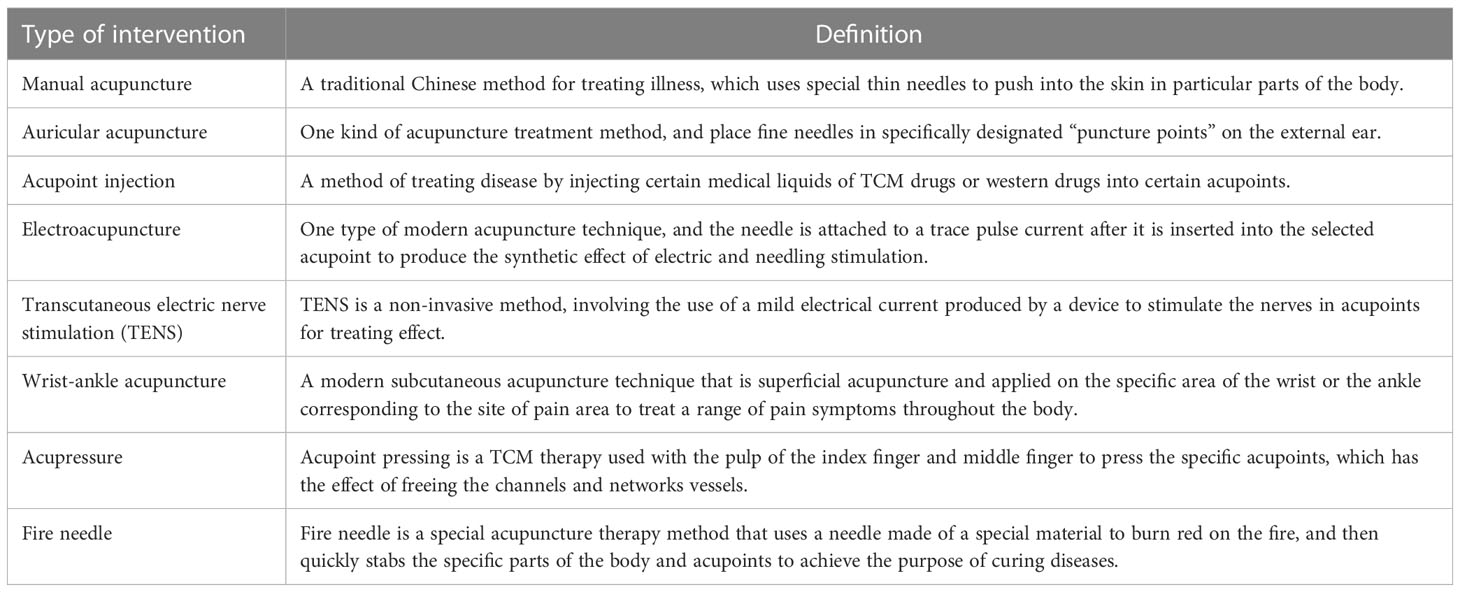
Table 3 Definitions of modalities of acupuncture and related therapies in this overview of systematic review.
Step 3: Study selection
Inclusion criteria
Studies that meet the following criteria were included:
(1) Type of studies. Systematic reviews and meta-analyses that examined the effectiveness or safety of acupuncture and related therapies for treating cancer pain.
(2) Type of participants. We included patients diagnosed with cancer pain.
(3) Type of interventions. The treatment group intervention of clinical research at least included a kind of acupuncture therapy (manual acupuncture, electroacupuncture, auricular acupuncture, etc.) or moxibustion therapy.
(4) Type of comparators. There is no limitation about the type of comparators.
(5) Types of outcome measures. Primary outcomes included pain relief rate, VAS scores, Pain Numerical Rating Scale (NRS) score, Analgesic efficacy, EORTC QLQ-C30 scores, etc.
Exclusion criteria
Studies were excluded if:
(1) Duplicated. The research team eliminated the duplicates, due to the possibility of the paper appearing more than one time;
(2) Publications were not full reports;
(3) Protocol of research;
A two-step study selection was used in this review. A first exclusion by title and abstract was made using the inclusion/exclusion criteria by author A (Yanji Zhang) and B (Yingrong Zhang). Subsequently, 2 other researchers (Suzhen Liu and Yiwei Wang) retrieved the full-text for further screening to determine whether the studies should be included or excluded. If there is a disagreement, we would have a discussion with another people (Jia Li) in our panel.
Step 4: Charting the data
A standardized set of data extraction items guided by our research question were developed and piloted at the protocol stage to extract key data from the included studies. Data extraction was performed by author A (Yanxin Yu) and B (Hongjie Xia), and checked by anther author (Chang Wang and Chun Wang).
Variables were extracted for the following key groupings: 1. identifying information: Title, article language, the author of article, institution, publication date, nationality, publication journal, and type of funding; 2. Characteristics of intended participants: patient’s age, patient’s gender, and sample size; 3. Methodological details: study design, type of interventions, type of comparators, and types of outcome measures; 4. Results and discussion: significant findings, conclusions, limitations, and suggestion for future research. A preliminary set of data extraction items for this protocol are shown in Table 4.
Step 5: Collating, summarizing, and reporting the findings
Analysis: Both quantitative analysis based on numerical counts (i.e., characteristics of included studies, analysis of the main outcome) and qualitative analysis through a narrative synthesis were provided. The quantitative analysis used the data from papers, focusing on the characteristics of the use of acupuncture in the treatment of cancer pain, the methodological details of clinical research of acupuncture for cancer pain, and the impact of the application of acupuncture for cancer pain. For the qualitative analysis, the focus is on the discussion of the studies as a way to determine if there are any gaps in researching and identifying the directions for future research.
Reporting: The data extracted from the study are presented in the form of tables and pictures. The results were briefly organized into a tabular format and analyzed using a narrative description. As scoping review research, there is no plan for subgroup analysis and sensitivity analysis of data.
Step 6: Expert consulting
Though this step is an optional one, it was applied to identify the gaps in our literature review. To enhance this scoping review, we relied on the expertise and experience of acupuncturists and methodological experts by providing feedback on it. Suggestions were taken into consideration to contribute to this scoping review.
Additional Step: Quality assessment:
Two researchers (Bocun Li and Yiwei Wang) evaluated the quality of included studies by using the AMSTAR2 tool in duplicate. Any disagreement was resolved by a third investigator (Yanxin Yu). The AMSTAR2 scale contains a total of 16 entries: Each entry is answered as “yes” or “no”, and some entries can be answered as “partial yes”. If no items are defective or there is only one non-key item that is defective, the methodological quality of the commented SR is high. When more than one non-key item is defective and no key item is defective, the methodological quality is judged into medium. When a key item is defective with or without non-critical item defects, the methodological quality is low. The methodological quality is extremely low when there is more than one key item defect, with or without non-critical item defects.
Results
Summary of included studies
A total of 227 articles were found (28 in PubMed, 4 in Cochrane Database, 2 in Web of Science, 109 in Embase, 40 in CNKI, 7 in VIP, 17 in CBMdisc, and 20 in Wanfang Database). Duplicates were excluded and 149 citations were exported to EndNote (EndNote X9, Thomson Reuters, New York, USA). The first exclusion by title and abstract was made by using the inclusion/exclusion criteria, by author Yanxin Yu and author Hongjie Xia. Afterwards, the 2 same researchers retrieved the full text for further screening to determine whether studies should be included or excluded. If there is a disagreement, we would have a discussion with other people (Jia Li) in our panel. Totally, 32 articles were reserved following inclusion criteria and found the full-text. Meanwhile, 1 article was the animal model experiment (18), 2 articles were the letter’s response to the author (19, 20), and 3 protocols were verified (21–23), so there were 25 articles for the scoping reviews (see Figure 1). Only 2 included articles did not conduct a meta-analysis, while 23 reviews have done the meta-analysis to determine the outcomes. The median number of the used databases was 7.5, and seven databases were commonly used (12/25), with a range of 5-14 databases. Most reviews were conducted from the inception of databases, and 5 reviews from the specific date of databases, such as 1950, 1966, 1986, 1999, and 2005 (24–28).
Population, interventions, comparators, and outcomes of included reviews
The summary of population, interventions, comparators, and outcomes of included reviews are shown in Table 5. Supplementary material 3 presents the characteristics of each review, and Figure 2 displays the assessed outcome. All the articles had no restriction on gender. Table 4 shows that 56.00% of reviews had no restriction on age (14/25), and 44.00% of reviews paid more attention to adults (11/25).
All the interventions are presented in Table 4: Manual acupuncture is the most frequently included types of test group intervention (n=12), about 50%, followed by acupuncture + medicine (n=7), auricular acupuncture (n=3), acupoint injection, transcutaneous electric nerve stimulation (TENS), wrist-ankle acupuncture + medicine, wrist-ankle acupuncture, electroacupuncture, auricular acupuncture + medicine, and catgut embedding at acupoint + medicine (n=2). Other interventions only refer to one time. Meanwhile, different types of acupuncture (e.g. fire needle) and different kinds of auricular acupuncture (needle, pill, and injection) were mentioned. A total of 12 reviews mentioned medicine as the control group (15, 24, 26, 27, 29–37), 12 reviews described placebo acupuncture as the control group (15, 24, 31–33, 36, 38–43) and 5 reviews clearly showed the analgesics as the control group (28, 31, 38, 42, 44). Three studies included three-step analgesia medicine (25, 45, 46), blank control appeared in 2 articles (43, 47), sham acupuncture was in 2 reviews (32, 38), and 1 review included sham electroacupuncture (31), radiotherapy and chemotherapy appeared (42). The duration of the session ranged from 7 days to 6 weeks. Most timing of assessment is 7 days or 14 days. All the included RCTs/qRCTs in reviews didn’t set up a follow-up period to observe long-term efficacy.
The included reviews comprised the following study designs: RCT(18/25) (24–26, 28, 29, 31, 33, 36–45, 47), RCT and qRCT (7/25) (15, 27, 30, 32, 34, 35, 46). 22 reviews did not show the specific cancer pain diagnosis standard, and only 3 reviews presented disease diagnosis standard (25, 36, 41). As the type of cancer, 23 reviews showed multi-type cancer, and only 2 reviews referred to specific cancer, lung cancer and liver cancer (28, 46).
Totally, all reviews assessed efficacy, and only about 40.00% (10/25) reported safety (15, 25–29, 36, 39, 42, 47). Many reviews required included studies to contain either a efficacy or safety-related outcome (10/25) (15, 25–29, 36, 39, 42, 47).
As shown in Figure 2, pain relief rate was the most frequently assessed outcome in reviews (n=11), closely followed by visual analogue scales (VAS) (5/25) and analgesia duration (3/25). Figure 3 shows that pain relief rate was not the main outcome between 2005 and 2010. After 2011, pain relief rate has become the commonly used main outcome, and after 2016 pain relief rate was the most frequently assessed outcome in reviews (n=7).
Quality assessment
The quality of the systematic reviews and meta-analyses as determined by AMSTAR 2 is presented in Table 6. All reviews have done search strategy comprehensively, and all the reviews have been screened by 2 reviewers independently. However, 9 reviews didn’t clarify the reason for excluding articles and 1 review did not explain the information in details (38). Two reviews didn’t carry out the meta-analysis and did not have adequate information to analyze the risk of bias of included clinical studies (30, 47). Only 1 review indicated that their review was registered with PROSPERO (38), 22 reviews used a tool that addressed all the risk of bias components, and 4 reviews did not (28, 30, 35, 47). However, nearly 95% of included RCTs/qRCTs in review didn’t report blinding of participants/investigators and had a high risk.
Systematic review findings
All the reviews have declared that acupuncture is an effective method for cancer pain treatment. Totally, 11 reviews aiming at evaluating the safety also have confirmed that acupuncture is safe for treating cancer pain. On the other hand, compared with western medicine, acupuncture has a greater advantage in security and can reduce side effects happening, such as nausea, vomiting, constipation, and dizziness. Nearly all the included interventions can mitigate the degree of pain, such as manual acupuncture, sham acupuncture, wrist-ankle acupuncture, conventional care, and so on. Table 7 shows the findings from included studies.
Recommendations for future reviews
The 18 reviews included studies primarily conducted in China, and researchers in the UK conducted 5 reviews. Most reviews did not describe the diagnosis of cancer pain, and only 3 articles have done; 23 studies included multi-type cancer, and 2 articles refer to liver cancer and lung cancer. As for the adverse events, only 6 reviews related, and 2 reviews explained the adverse reactions and numbers of patients in details. (Table 8)
Consulting results from experts
Six experts were consulted and provided advice. All experts agreed that acupuncture is an effective and safety method for cancer pain treatment. More than two-thirds of experts believed that electroacupuncture has a better significant effect on cancer pain among these acupuncture therapies. Two experts mentioned that attention should be paid to the combined application of acupuncture therapies in the clinical practice of acupuncture for cancer pain.
Discussion
In this scoping review, 25 systematic reviews of acupuncture for cancer pain management were included, which evaluated numerous primary studies with various study designs and qualities. They were published from 2005 to 2021: 18 were conducted in China, 5 in the UK (24, 31, 33, 40, 41), 2 in Korea (32, 42), and 1 in the USA (30). And, 24 out of 26 included reviews that covered multi-types of cancer; 1 included liver cancer from 2005 to 2021 (28), and 1 systematic review of lung-cancer-only reported negative results, without positive results from others (31). The methodological quality of included evidence was relatively poor. Only 2 systematic reviews (15, 39) we included were deemed of moderate or high methodological quality and 23 systematic reviews were deemed to be quietly low. Overall, the synthesis of these systematic reviews was broad, and there are lots of opportunities to improve the qualities of future evidence in this field.
Effect of Acupuncture for cancer pain based on evidence
In terms of therapeutic effect, based on the results of our review, it is confirmed that acupuncture has an accurate effect to alleviate cancer pain. Most original trials indicate the safety and effectiveness of acupuncture targeted to patients suffering from cancer pain. Though the result is encouraging, and the future application of acupuncture is promising, the heterogeneity and the research quality of original studies still seem worrisome.
As for interventions, a few systematic reviews sought a broad definition of acupuncture, and many sorts of acupuncture interventions were included: 20 reviews targeted at intervention compounded of two or more sorts of acupuncture, and only 6 systematic reviews confined to single interventions (24, 30, 31, 39–41). Some reviews reported that compounded intervention of acupuncture has superior effectiveness than a single intervention (32, 44, 48). Comparing different acupuncture types, the number of studies related to auricular acupuncture (n=3) was more than that related to electro-acupuncture (n=2). More reviews focused on the combination of acupuncture therapies and medicine (n=19) than the combination of acupuncture therapies (n=1). As for types of cancer pain, most studies (n=23) included multi-type cancer, only 2 articles refer to liver cancer and lung cancer. Therefore, the evidence of acupuncture in the treatment of cancer pain related to liver cancer and lung cancer is more sufficient. Follow-up clinical studies on acupuncture for cancer pain caused by breast cancer, colorectal cancer and other cancers should be carried out. The therapeutic effects of acupuncture on cancer pain caused by different types of cancer should be compared. At the same time, no studies reported the relative priority levels among manual acupuncture, electro-acupuncture, and auricular acupuncture. No study reported whether there is a synergism or additive effect between diverse acupuncture interventions in cancer pain.
Strengths and limitations
The strengths of this scoping review are as follows. Methodology based on an accepted framework was used for scoping reviews, with more than 3 researchers assessing the quality and results of included articles in duplicate. Also, a rigorous assessment has done the included reviews using AMSTAR 2. In addition, none of the primary study places restrictions on the age or gender of patients, which increases the representative of the sample enrolled to original SR.
The limitation of this scoping review is that most included studies were conducted in China, especially in Guangdong and Zhejiang Province. With certain geographical limitations, the findings were not representative within the region. More studies need to conducted in other settings by other investigators to determine the true effects of acupuncture. Evidence has proved that different types of cancer pain may have different pain features (49). The results of our review may owe to the synthesis of all kinds of cancer pain, and only 2 reviews described the type of cancer pain in detail. It remains to figure out whether acupuncture has an affinity for certain types of pain. All reviews assessed intervention efficacy, but fewer than a quarter assessed a component, including a reach, engagement, safety, or cost-effectiveness.
Summary and conclusion
This scoping review synthesizes and evaluates existing evidence of acupuncture for cancer pain. From this scoping review of systematic reviews and meta-analyses, there are clear recommendations for future studies: expanding the region of research in the world and trying to conduct the study of different types of cancer pain in details as much as possible. Evidences of acupuncture for cancer pain can inform clinical decision-making.
Data availability statement
The original contributions presented in the study are included in the article/Supplementary Material. Further inquiries can be directed to the corresponding authors.
Author contributions
YaZ, YiZ, SL, BL and ZS have contributed equally to this work. JL and ChuW had full access tothe study data and take responsibility for the integrity and accuracy of data analysis. Concept and design: All authors. Acquisition, analysis, or interpretation of data: YaZ, YiZ, JL, SZ, ChuW. Drafting of the manuscript: YaZ, YiZ, SL. Critical revision of the manuscript: JL, ChuW, ChaW. Intellectual content: YaZ, YiZ, SL, BL, ZS, ChW, JL. Statistical analysis: QH, SSL, YiZ, YW, YY, HX. Quality assessment: BL, YW, YY. All authors contributed to the article and approved the submitted version.
Funding
Supported by National Administration of Traditional Chinese Medicine: The construction project of the national famous Chinese medicine expert inheritance studio in 2022 (National Chinese Medicine Education Letter No.75[2022], Professor Wang Huang); The Seventh Batch of National Old Chinese Medicine Experts Academic Experience Inheritance Project (National Chinese Medicine Education Letter No.272[2021]); Hubei University of Science and Technology Fund Project (No. 2022-23X05 to Zhe Song); Hubei Province Natural Science Foundation (2022CFB367); 2018 Xianning Central Hospital Scientific Research Project (2018XYA003); The 2nd Hubei Province’s Outstanding Medical Academic Leader Program (Health Commission of Hubei Province Notice No.[2019]47); Qihuang Engineering Project of National Administration of Traditional Chinese Medicine (Document No. 284 (2018)).
Acknowledgments
Showing appreciation to the included 25 reviews provided datas, Zhongyu Zhou, Wei Huang, Jiajie Wang (Department of Acupuncture, Hubei Provincial Hospital of Traditional Chinese Medicine) provided constructive comments and received no compensation for this contribution. Thanks to all the peer reviewers for their constructive comments and suggestions.
Conflict of interest
The authors declare that the research was conducted in the absence of any commercial or financial relationships that could be construed as a potential conflict of interest.
Publisher’s note
All claims expressed in this article are solely those of the authors and do not necessarily represent those of their affiliated organizations, or those of the publisher, the editors and the reviewers. Any product that may be evaluated in this article, or claim that may be made by its manufacturer, is not guaranteed or endorsed by the publisher.
Supplementary material
The Supplementary Material for this article can be found online at: https://www.frontiersin.org/articles/10.3389/fonc.2023.1169458/full#supplementary-material
References
1. Neufeld NJ, Elnahal SM, Alvarez RH. Cancer pain: a review of epidemiology, clinical quality and value impact. Future Oncol (2017) 13(9):833–41. doi: 10.2217/fon-2016-0423
2. Te Boveldt N, Vernooij-Dassen M, Burger N, Ijsseldijk M, Vissers K, Engels Y. Pain and its interference with daily activities in medical oncology outpatients. Pain Physician (2013) 16:379–89. doi: 10.36076/ppj.2013/16/379
3. Simone CB 2nd, Vapiwala N, MK H, Metz JM. Cancer patient attitudes toward analgesic usage and pain intervention. Clin J Pain (2012) 28(2):157–62. doi: 10.1097/AJP.0b013e318223be30
4. Kurtin S, Fuoto A. Pain management in the cancer survivor. Semin Oncol Nurs (2019) 35(3):284–90. doi: 10.1016/j.soncn.2019.04.010
5. Paice JA, Portenoy R, Lacchetti C, Campbell T, Cheville A, Citron M, et al. Management of chronic pain in survivors of adult cancers: American society of clinical oncology clinical practice guideline. J Clin Oncol (2016) 34(27):3325–45. doi: 10.1200/JCO.2016.68.5206
6. Deng G. Integrative medicine therapies for pain management in cancer patients. Cancer J (2019) 25(5):343–8. doi: 10.1097/PPO.0000000000000399
7. Kurita GP, Sjøgren P. Management of cancer pain: challenging the evidence of the recent guidelines for opioid use in palliative care. Pol Arch Intern Med (2021) 131(11):1–5. doi: 10.20452/pamw.16136
8. Paul AK, Smith CM, Rahmatullah M, Nissapatorn V, Wilairatana P, Spetea M, et al. Opioid analgesia and opioid-induced adverse effects: a review. Pharm (Basel) (2021) 14:1091. doi: 10.3390/ph14111091
9. Ruano A, García-Torres F, Gálvez-Lara M, Moriana JA. Psychological and non-pharmacologic treatments for pain in cancer patients: a systematic review and meta-analysis. J Pain Symptom Manage (2021) 63(5), e505–e520. doi: 10.1016/j.jpainsymman.2021.12.021
10. National Comprehensive Cancer Network. NCCN clinical practice guidelines in oncology (NCCN guidelines), in: Adult cancer pain. version 1 . Available at: https://www.nccn.org/professionals/default.aspx (Accessed 10, 2018).
11. Sutton D, McCormack S. Acupuncture for chronic non-cancer pain: a review of clinical effectiveness, cost effectiveness and guidelines. Ottawa (ON: Canadian Agency for Drugs and Technologies in Health (2019).
12. He Y, Guo X, May BH, Zhang AL, Liu Y, Lu C, et al. Clinical evidence for association of acupuncture and acupressure with improved cancer pain: a systematic review and meta-analysis. JAMA Oncol (2020) 6(2):271–8. doi: 10.1001/jamaoncol.2019.5233
13. Yang J, Wahner-Roedler DL, Zhou X, Johnson LA, Do A, Pachman DR, et al. Acupuncture for palliative cancer pain management: systematic review. BMJ Support Palliat Care (2021) 11(3):264–70. doi: 10.1136/bmjspcare-2020-002638
14. Li DH, Su YF, Fan HF, Guo N, Sun CX. Acupuncture combined with three-step analgesic drug therapy for treatment of cancer pain: a systematic review and meta-analysis of randomised clinical trials. Evid Based Complement Alternat Med (2021) 2021:5558590. doi: 10.1155/2021/5558590
15. Yang Y, Wen J, Hong J. The effects of auricular therapy for cancer Pain:A systematic review and meta-analysis. Evid Based Complement Alternat Med (2020) 2020:1618767. doi: 10.1155/2020/1618767
16. Ge L, Wang Q, He Y, Wu D, Zhou Q, Xu N, et al. International trustworthy traditional Chinese medicine recommendations (TCM recs) working group. acupuncture for cancer pain: an evidence-based clinical practice guideline. Chin Med (2022) 17(1):8. doi: 10.1186/s13020-021-00558-4
17. Tricco AC, Lillie E, Zarin W, KK O, Colquhoun H, Levac D, et al. PRISMA extension for scoping reviews (PRISMA-ScR): checklist and explanation. Ann Intern Med (2018) 169(7):467–73. doi: 10.7326/M18-0850
18. Yu ML, Qian JJ, Fu SP, Chen JY, Zheng YW, Lu ZG, et al. Acupuncture for cancer-induced bone pain in animal models: a systemic review and meta-analysis. Evid Based Complement Alternat Med (2020) 2020:5606823. doi: 10.1155/2020/5606823
19. Cheon S, Lee H. Correspondence regarding anshasi and ahmad's “an assessment of methodological quality of systematic reviews of acupuncture and related therapies for cancer-related pain” in complement ther clin pract 2018 august. Complementary Therapies Clin Pract (2018) 33:138. doi: 10.1016/j.ctcp.2018.09.008
20. Carole paley. Acupuncture for the treatment of cancer pain: a systematic review. response to authors. SUPPORTIVE Care IN Cancer (2013) 21:1217. doi: 10.1007/s00520-012-1704-4
21. Jiao Y, Guixing X, Zihan Y, Ying C, Shengming S, Qianhua Z, et al. Acupuncture for chronic cancer-related pain: a systematic review and network meta-analysis protocol. BMJ Open (2020) 10:e039087. doi: 10.1136/bmjopen-2020-039087
22. Jingchun Z, Runjin Z, Zhenke L, Na Z, Zijun L, Guohua L. Clinical evidence of acupuncture and related therapy in patients with cancer-pain: a protocol for systematic review and meta-analysis. Medicine (2020) 99:e23119. doi: 10.1097/MD.000applicable0000000023119
23. Jisheng W, Yi L, Binghao B, Xudong Y, Hengheng D, Fei C, et al. Acupuncture for pain caused by prostate cancer: protocol for a systematic review. Medicine (2019) 98:e13954. doi: 10.1097/MD.0000000000013954
24. Hurlow A, Bennett MI, Robb KA, Johnson MI, Simpson KH, Oxberry SG. Transcutaneous electric nerve stimulation (TENS) for cancer pain in adults. Cochrane Database Syst Rev (2012) 2012:CD006276. doi: 10.1002/14651858.CD006276.pub3
25. Jianfeng W, Tao L, Tian Z, Zhihan W, Dianna L, Hua D, et al. A meta-analysis of the efficacy and safety of acupuncture combined with three-step analgesic ladder on cancer pain. J Emergency Traditional Chin Med (2020) 29:1140–4. doi: 10.3969/j.issn.1004-745X.2020.07.005
26. Jie Z, Yi L, Qin C, Jianqiao F. Meta-analysis on randomized controlled clinical trials of point injection on cancer pain. J Zhejiang Chin Med Univ (2014) 7:927–32. doi: 10.16466/j.issn1005-5509.2014.07.024
27. Yi Z, Yonghui Y, Fanfu F. Meta-analysis on wrist-ankle acupuncture of cancerous pain. J Liaoning Univ Traditional Chin Med (2014) 16:152–5. doi: 10.13194/j.issn.1673-842x.2014.01.055
28. Qizhe S, Mei Y. Systematic review of acupuncture combined with acupoint injection in the treatment of liver cancer pain. For all Health (2013) 7:184–6.
29. Li D-h, Su Y-f, Fan H-f, Guo Na, Sun C-x. Acupuncture combined with three-step analgesic drug therapy for treatment of cancer pain: a systematic review and meta-analysis of randomised clinical trials. Evidence-Based Complementary Altern Med (eCAM) (2021) 2021:5558590. doi: 10.1155/2021/5558590
30. Yang J, Wahner-Roedler DL, Zhou X, Johnson LA, Do A, Pachman DR, et al. Acupuncture for palliative cancer pain management: systematic review. BMJ supportive palliative Care (2021) 0:1–7. doi: 10.1136/bmjspcare-2020-002638
31. Paley CA, Johnson MI, Tashani OA, Bagnall AM. Acupuncture for cancer pain in adults. Cochrane Database Syst Rev (2015) 2015:CD007753. doi: 10.1002/14651858.CD007753.pub3
32. Choi TY, Lee MS, Kim TH, Zaslawski C, Ernst E. Acupuncture for the treatment of cancer pain: a systematic review of randomised clinical trials. Support Care Cancer (2012) 20:1147–58. doi: 10.1007/s00520-012-1432-9
33. Paley CA, Johnson MI, Tashani OA, Bagnall AM. Acupuncture for cancer pain in adults. Cochrane Database Systematic Rev (2011) 1:CD007753. doi: 10.1002/14651858.CD007753.pub2
34. Yu Z, Fang W, Wenhua G, Ruihan L, Jing W, Yu W. Meta-analysis of acupoint application adjuvant treat cancer pain. Chin Evidence-Based Nurs (2018) 4:309–15. doi: 10.3969/j.issn.2095-8668.2018.04.003
35. Ge S, Zhiliang Z, Lei Z. Systematic review on clinical efficacy of wrist ankle acupuncture therapy for pain syndrome. Chin Arch Traditional Chin Med (2011) 33:1715–1719+1756. doi: 10.02-2619(2011)11-1715-06
36. Jie Z, Yi L, Qin C, Jianqiao F. Meta-analysis on randomized controlled clinical trials of auricular acupuncture on cancer pain. Chin Arch Traditional Chin Med (2014) 32:2326–30. doi: 10.13193/j.issn.1673-7717.2014.10.006
37. Tingyu C, Xunxing L, Fengzhen F. Meta analysis of external application of Chinese medicine on ashi points on cancer pain. Clin J Traditional Chin Med (2019) 31:706–12. doi: 10.16448/j.cjtcm.2019.0207
38. He Y, Guo X, May BH, Zhang AL, Liu Y, Lu C, et al. Clinical evidence for association of acupuncture and acupressure with improved cancer pain: a systematic review and meta-analysis. JAMA Oncol (2020) 6:271–8. doi: 10.1001/jamaoncol.2019.5233
39. Caiqiong Hu, Haibo Z, Wanyin Wu, Weiqing Yu, Yong Li, Jianping B, et al. Acupuncture for pain management in cancer: a systematic review and meta-analysis. Evidence-Based Complementary Altern Med (2016) 2016:1720239. doi: 10.1155/2016/1720239
40. Paley CA, Tashani OA, Bagnall AM, Johnson MI. A cochrane systematic review of acupuncture for cancer pain in adults. BMJ Support Palliat Care (2011) 1:51–5. doi: 10.1136/bmjspcare-2011-000022
41. Robb KA, Bennett MI, Johnson MI, Simpson KJ, Oxberry SG. Transcutaneous electric nerve stimulation (TENS) for cancer pain in adults. Cochrane Database Systematic Rev (2008) 3:CD006276. doi: 10.1002/14651858.CD006276.pub2
42. Lee H, Schmidt K, Ernst E. Acupuncture for the relief of cancer-related pain–a systematic review. Eur J Pain (2005) 9:437–44. doi: 10.1016/j.ejpain.2004.10.004
43. Caiqiong H, Haibo Z, Yanjuan Z, Aihua O. Literature evaluation and meta-analysis of the therapeutic effect of acupuncture in 1639 patients with cancer pain. Clinical Innovation and Standardization Forum of Traditional Chinese Medicine Oncology (2015) 2015:141–150.
44. Dong B, Lin Lu, Chen Q, Qi Y, Wang F, Qian K, et al. Wrist-ankle acupuncture has a positive effect on cancer pain: a meta-analysis. BMC complementary Med therapies (2021) 21:24. doi: 10.1186/S12906-020-03193-Y
45. Pu Y, Jianrong H, Yuanchun W. Meta-analysis of clinical efficacy and safety of acupuncture combined with three-step analgesia in the treatment of cancer pain. Shanghai J Acupuncture Moxibustion (2021) 40:366–72. doi: 10.13460/j.issn.1005-0957.2021.03.0366
46. Shuanglin B, Jiarui Z, Jianshua Q, Qing C, Wei Z, Hongbin W, et al. Meta-analysis of acupuncture combined with three-step analgesic in the treatment of lung cancer pain. J Basic Chin Med (2020) 26:1143–7. doi: 1006-3250(2020)08-1143-05
47. Hao P, Haidong P, Ling X. Lixing L.Efficacy of acupuncture in treatment of cancer pain: a systematic review. J Integr Med (2010) 6:501–9. doi: 10.3736/jcim20100601
48. Wu X, Chung VC, Hui EP, Ziea ET, Ng BF, Ho RS, et al. Effectiveness of acupuncture and related therapies for palliative care of cancer: overview of systematic reviews. Sci Rep (2015) 5:16776. doi: 10.1038/srep16776
Keywords: acupuncture, cancer pain, scoping review, systematic reviews and meta-analyses, alternative medicine (AM)
Citation: Zhang Y, Zhang Y, Liu S, Li B, Song Z, Han Q, Wang C, Wang Y, Yu Y, Xia H, Wang C and Li J (2023) Acupuncture for cancer pain: a scoping review of systematic reviews and meta-analyses. Front. Oncol. 13:1169458. doi: 10.3389/fonc.2023.1169458
Received: 19 February 2023; Accepted: 25 April 2023;
Published: 15 May 2023.
Edited by:
Xiaodong Sheldon Liu, Beijing University of Chinese Medicine, ChinaReviewed by:
Linqing Miao, Beijing Institute of Technology, ChinaI-Shiang Tzeng, National Taipei University, Taiwan
Copyright © 2023 Zhang, Zhang, Liu, Li, Song, Han, Wang, Wang, Yu, Xia, Wang and Li. This is an open-access article distributed under the terms of the Creative Commons Attribution License (CC BY). The use, distribution or reproduction in other forums is permitted, provided the original author(s) and the copyright owner(s) are credited and that the original publication in this journal is cited, in accordance with accepted academic practice. No use, distribution or reproduction is permitted which does not comply with these terms.
*Correspondence: Jia Li, ljlijia@163.com; Chun Wang, hispen@126.com
†These authors have contributed equally to this work
 Yanji Zhang
Yanji Zhang Yingrong Zhang1†
Yingrong Zhang1† Suzhen Liu
Suzhen Liu Yanxin Yu
Yanxin Yu Jia Li
Jia Li